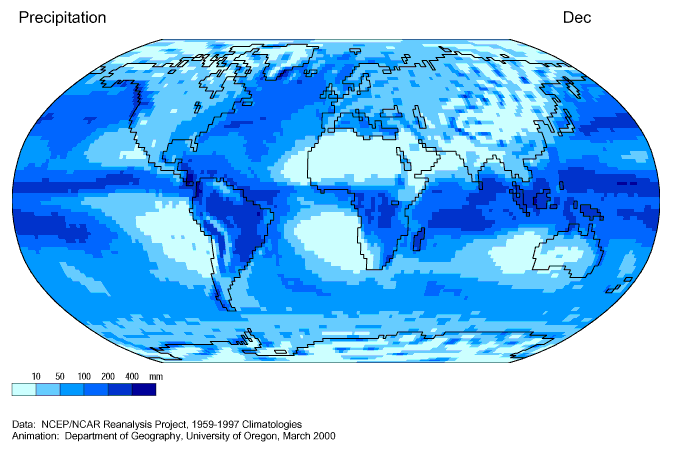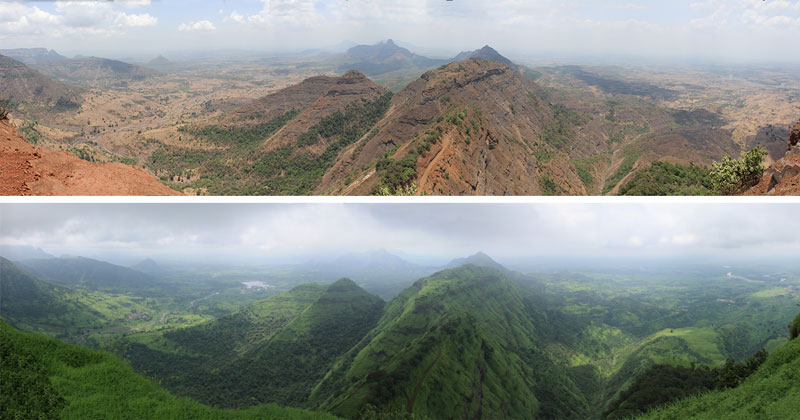If you are looking for monsoons, you’ll need to head to the tropics. That’s where rain is produced as warm and humid air rises in the Intertropical Convergence Zone (ITCZ), which swings north and south in a seasonal cycle, causing patterns of distinctly wet and dry seasons (explore Why Monsoons Happen to learn more about how this works).
However, monsoons are not the same throughout the tropics, because the specific locations of continents and oceans influence the regional patterns of winds and rain. Classic conditions for strong monsoons are found where the Indian Ocean and the Pacific Ocean meet. This region includes India and South Asia to the north of the equator and Australia south of the equator. Strong swings between wet summers and dry winters are found in those places as the ITCZ moves back and forth across the equator. The South Asian monsoon, which includes the Indian monsoon, is especially strong because the Himalayas and other mountains block dry air in the north from getting to the humid monsoon region. The seasonally wet and dry region just south of the Sahara Desert in West Africa and the Sahel is another classic monsoon region. Monsoons occur in the Americas too, but tend to be weaker than in other regions.
The animated map below shows how precipitation varies through a typical year. Notice that most precipitation occurs in the tropics and swings north and south of the equator with the seasons. This seasonal shift in the location of tropical precipitation indicates a shift in the location of the ITCZ and is the reason why there are distinct wet and dry seasons on tropical continents.

Asia, India, and Australia
With the world’s strongest monsoons, this region stretches from the South China Sea into the Indian Ocean and includes Asia and the northern end of Australia. From June until September, summer monsoon rains occur in South Asian countries such as Vietnam, Thailand, Cambodia, Bangladesh, Laos, India, and Pakistan. From December until February, the monsoon rains move south of the equator towards Australia while South Asia experiences dry monsoon conditions. There is even an East Asian monsoon that brings summer rain to China, Japan, and Korea, but it is caused by a different type of wind pattern associated with the jet stream.

The Americas
Monsoon winds in the tropical parts of North America, Central America, and South America cause the amount of rainfall to vary with the seasons, even in areas where precipitation is plentiful and rainforests thrive. From June to August, which are summer months in the Northern Hemisphere, there is more rainfall north of the equator in Costa Rica, Nicaragua, Panama, and western Mexico. From December to February there is more rainfall south of the equator in Brazil. The North American monsoon does bring moisture from the warm waters of the Pacific into the U.S. Southwest, but its peak rainfall occurs in Mexico, and the U.S. states of Arizona and New Mexico lie in its periphery. These areas are typically dry but can receive enough rainfall to quell a wildfire if moist monsoon winds blow in summer. An area of summer rainfall along the U.S. East Coast is associated with what some might call a mid-latitude version of monsoon rainfall.
Africa
During Northern Hemisphere summer, the Intertropical Convergence Zone (ITCZ) over Africa lies far north of the equator, just south of the Sahara Desert in an area known as Sub-Saharan Africa. Moist winds blow from the Atlantic and produce rain once they reach West Africa in countries such as Mali, Niger, Ghana, and the Ivory Coast. During Southern Hemisphere summer, the ITCZ lies south of the equator and brings rain to southern African countries such as Zimbabwe, Tanzania, Zambia, Malawi, Mozambique, and Uganda. Meanwhile, sub-Saharan Africa becomes particularly hot and dry in winter as air descends from high in the atmosphere to the ground as part of the Hadley Circulation.

I like view about Panorama Point on the Matheran Hill about 50 miles east of Mumbai, India
Can you please let me know the duration of the rainfall occurs every year say 2 months or 3 months.
awsome guys
please provide information about the human activity of monsoon prone area.
not helpful and did not make cents